Dual Wrecks (2/2)


Adonis and Rusland
By Daniel Berg
The New Jersey coast is littered with hundreds of shipwrecks. Many of these wrecks are within easy swimming distance of the beach. One of the most popular of these sites consists of not one but two shipwrecks and is known as the Dual Wrecks.
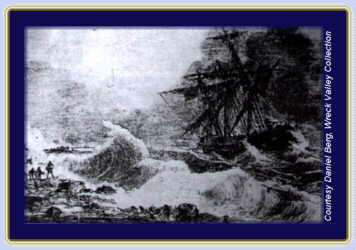
The Adonis was built in Bremen, Germany, in 1853 and displaced 550 gross tons. She was owned by F. Best & Company and valued at $20,000. The Adonis was en-route from Newcastle, England to New York and under the command of Captain Bosse when she struck the beach at 11:00 PM during a heavy fog on March 8, 1859. The wood-hulled vessel was carrying a cargo of 124 grindstones, 600 lead ingots, 39 casks of ground flint, 100 casks alkali, 501 casks of soda, 170 casks of powder, 130 casks of carb soda, 200 casks V. red, and 500 kegs C. soda. Her entire crew was taken off by rescuers from life-saving station number four. The wrecking schooners Ringold and Nora were dispatched to the scene. Steam pumps were fitted into the vessel's hold to try to reduce the water and re-float the Adonis but these efforts were soon abandoned due to rough weather. On March 18th of the same year, the vessel broke up in the pounding surf. In the 1960s divers recovered over 300 of the lead ingots she was carrying. Each weighed 115 pounds and had the name Locke Blackett & Co. embossed into them. These early divers also found grindstones ranging in size from two feet to six feet in diameter.
The second wreck to run aground on the same site was the Red Star Line steamship Rusland. She was built in 1872 by Dundee shipbuilders in Scotland and originally named the Kenilworth. She was 345 feet long, had a 37-foot beam, and displaced 2,538 tons. At 11:20 PM on March 17, 1877, under the command of Captain Jesse De Horsey, the Red Star steamer ran aground. A moderate gale was blowing from the northeast at the time, and a heavy sea prevailed. According to a statement from Captain DeHorsey, the Rusland had sailed into a dense fog, "The weather was thick with an occasional snow squall." "At 9 o'clock 20 fathoms were found and sea cakes were brought up. As these cakes have never to my knowledge been found west of Fire Island, I concluded that the vessel was off the Long Island coast." "Twenty - five minutes later the lookout cried Light on the port bow! I thought that a mistake had been made by the sailor, as there should have been a light on our starboard bow." "I telegraphed for the vessel to be put about. Before this could be done, however, she struck." According to the NEW YORK TIMES "The vessel headed straight on the beach, and keeled to the starboard side. She filled with water immediately afterward, and, from the volume which rushed in, it is supposed she must have struck a rock, making a hole in her hull."
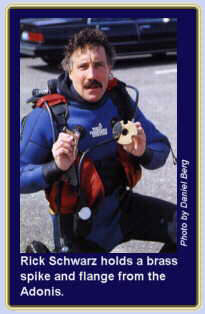
She was carrying 200 passengers and a cargo of plate glass and iron wire from Antwerp to New York. Rockets were discharged, which attracted the attention of Lifesaving Stations No 4 and 6. After many fruitless efforts, the life savors finally succeeded in getting a line over her bow. The apparatus for propelling a life-saving car was quickly attached and the slow work of hauling passengers ashore started. By 10:00 AM the next morning all the passengers and crew had been transported to the beach in the "life-saving car." Only two people could be conveyed in the car at a time.
At first salvage crews anticipated no problem pulling the liner off the beach. It was later discovered that the Rusland had actually landed on top of the Adonis and was now stuck fast onto the sunken wreck. On April 8th, the Rusland finally gave in to the constant pounding of the shore breakers and broke in two. This wreck along with the Adonis, are together known as the Dual Wrecks.
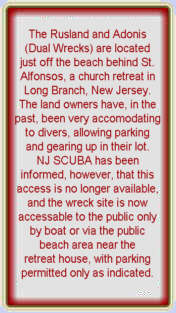
To get to the Dual Wrecks take the Garden State Parkway to Exit 105 East. Take Rt. 36 to the end and turn right on Ocean Ave. Drive south for 2.5 miles, you will see a red church on the right. The retreat house is opposite the church. Note that parking may be a little tricky. I have parked in the dirt lot behind the retreat house on several occasions and have never had a problem. Please remember that this is not public property and divers should use manners, courtesy, and good common sense when diving in the area.
The wrecks now sit in 25 feet of water just offshore and north of the tip of the jetty. The Rusland's sits parallel to the beach with her bow facing north. There is a large boiler on the site and divers certainly enjoy exploring her scattered remains. At the south end of the wreck, divers will find the Rusland's steel propeller almost on top of the Adonis wreck. The Adonis, which sits at a right angle to the Rusland, consists of low-lying wood ribs. Still visible on the Adonis are the remaining five and six-foot diameter grindstones she was transporting as part of her cargo. By digging in the sand just inshore of the grindstones divers can locate some barrels the Adonis was carrying as cargo. One barrel contained what appeared to be red dye. The wrecks sit in 25 feet of water and are more commonly known as the Dual Wrecks.
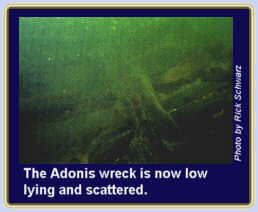
Be sure to check weather conditions before attempting to dive this site. It's important to have a west wind and high tide to assure the best possible sea and visibility conditions. The Dual Wrecks offer divers the chance to explore two shipwrecks in shallow water on the same dive. As far as New Jersey beach diving goes this is one of the premier dive sites and is highly recommended to anyone planning to visit the area.
For further information on other New Jersey beach dive sites including not only shipwrecks but jetties, inlets, bottle dives, and more, look for Dan Berg's book titled NEW JERSEY BEACH DIVER. For further information contact Aqua Explorers, Inc. PO Box 116, East Rockaway NY 11518 or call (516) 868-2658.
Original NJScuba website by Tracy Baker Wagner 1994-1996

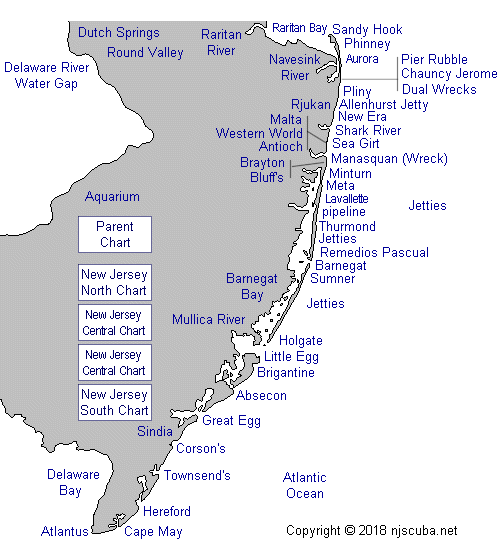
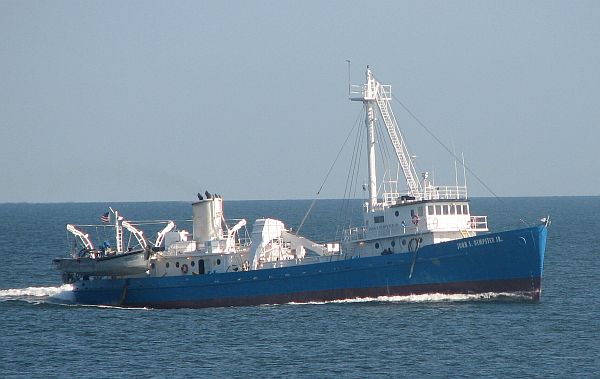
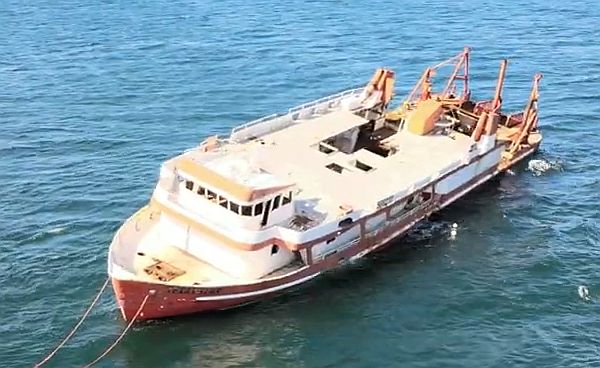
Questions or Inquiries?
Just want to say Hello? Sign the .